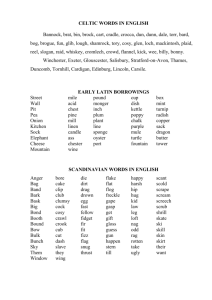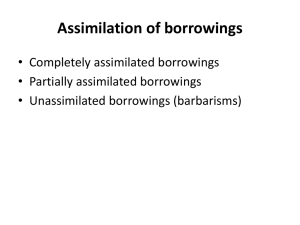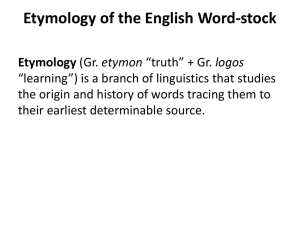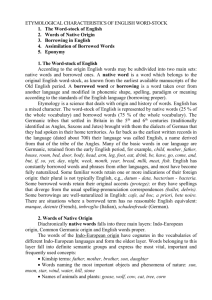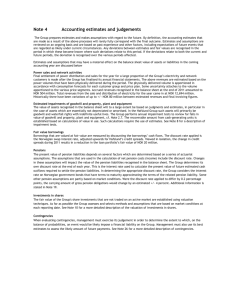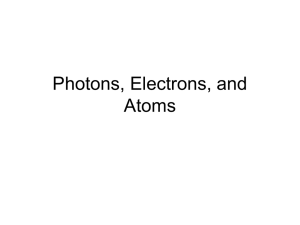№14. Theme: Borrowing. Text: Theory of Electrification Theme
advertisement
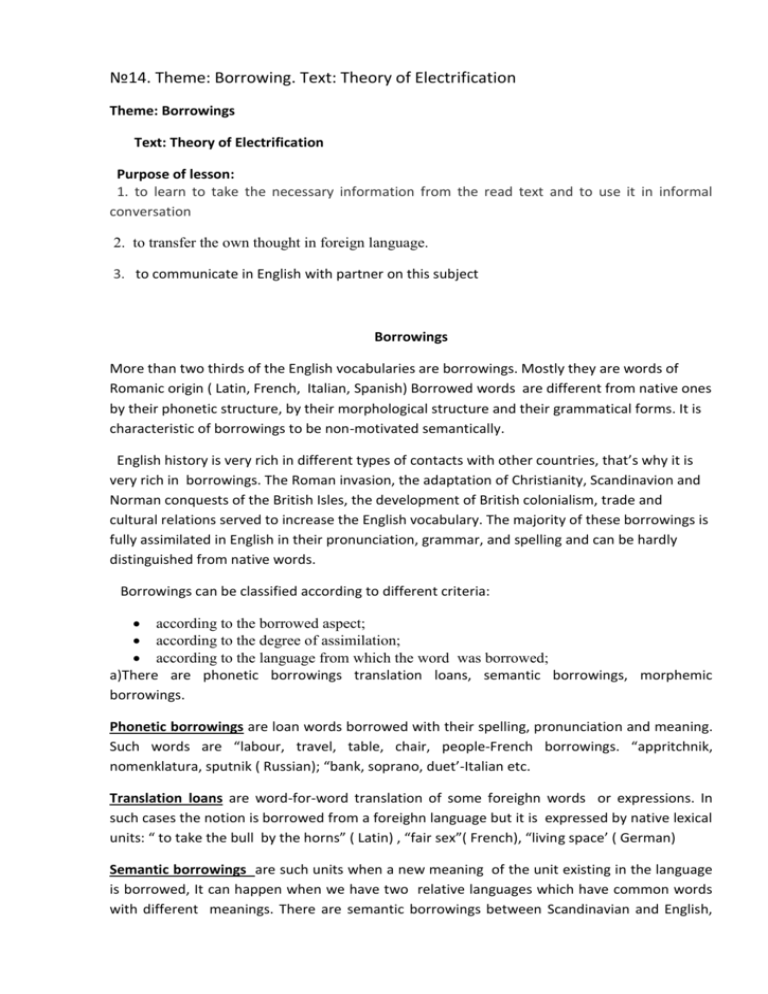
№14. Theme: Borrowing. Text: Theory of Electrification Theme: Borrowings Text: Theory of Electrification Purpose of lesson: 1. to learn to take the necessary information from the read text and to use it in informal conversation 2. to transfer the own thought in foreign language. 3. to communicate in English with partner on this subject Borrowings More than two thirds of the English vocabularies are borrowings. Mostly they are words of Romanic origin ( Latin, French, Italian, Spanish) Borrowed words are different from native ones by their phonetic structure, by their morphological structure and their grammatical forms. It is characteristic of borrowings to be non-motivated semantically. English history is very rich in different types of contacts with other countries, that’s why it is very rich in borrowings. The Roman invasion, the adaptation of Christianity, Scandinavion and Norman conquests of the British Isles, the development of British colonialism, trade and cultural relations served to increase the English vocabulary. The majority of these borrowings is fully assimilated in English in their pronunciation, grammar, and spelling and can be hardly distinguished from native words. Borrowings can be classified according to different criteria: according to the borrowed aspect; according to the degree of assimilation; according to the language from which the word was borrowed; a)There are phonetic borrowings translation loans, semantic borrowings, morphemic borrowings. Phonetic borrowings are loan words borrowed with their spelling, pronunciation and meaning. Such words are “labour, travel, table, chair, people-French borrowings. “appritchnik, nomenklatura, sputnik ( Russian); “bank, soprano, duet’-Italian etc. Translation loans are word-for-word translation of some foreighn words or expressions. In such cases the notion is borrowed from a foreighn language but it is expressed by native lexical units: “ to take the bull by the horns” ( Latin) , “fair sex”( French), “living space’ ( German) Semantic borrowings are such units when a new meaning of the unit existing in the language is borrowed, It can happen when we have two relative languages which have common words with different meanings. There are semantic borrowings between Scandinavian and English, e.g. “to live“for the word “to dwell’ which in OE had the meaning “to wander’ the meaning “ “gap’, подарок for the word ‘gift’ which in OE had the meaning ‘ выкуп за жену’ Morphemic borrowings are borrowings of affixes which occur in the language when many words with identical affixes are borrowed from one language into another b) Borrowings are subdivided into: completely assimilated; partly assimilated non-assimilated ( barbarisms) Completely assimilated borrowings. are not felt as foreign words. Completely assimilated borrowings belong words to regular verbs ( correct- corrected), form their plural by means of – s-inflexion( gate-gates). Partly assimilated borrowings are subdivided into the following groups: borrowings non- assimilated semantically, because they denote objects and notions peculiar to the country from the language of which they were borrowed, e.g. sari, sombrero, taiga, kvass; borrowings non- assimilated grammatically, e.g. bacillus-bacilli, phenomenonphenomena, datum- data, genius-genii,etc. borrowings non- assimilated phonetically, e.g. girl, get, give, kid, kill, kettle, German, child, life-live, police, cartoon, camouflage, bourgeois; borrowings can be partly assimilated graphically, e.g. Greek borrowings ‘y’ can be spelled in the middle of the word ( symbol, synonym), ‘ph’ denotes the sound [f] ( phoneme, morpheme), ’ch’ denotes the sound [k] ( chemistry, chaos), ‘ps’ denotes the sound [ s] psychology. Non-assimilated assimilated borrowings ( barbarisms) are borrowings which are used by Englishmen rather seldom and are non-assimilated, e.g. addio ( It), tete-a –tete ( French), dolce vita ( Ital), duende (span). Text: Theory of Electrification 1. Historically there have been two outstanding theories of electrification: the one-fluid theory of Benjamin Franklin and the two-fluid theory of Charles Du Fay,. According to the two-fluid theory, all objects contain equal amounts of two fluids. When two different substances are rubbed together, one kind of fluids (positive0 is spread over one object and the other kind of fluid (negative0 over the other. 2. According to the one-fluid theory of Franklin, all bodies contain a certain specified amount of an “electric fire” or fluid to keep them in an uncharged or neutral state. When two objects are rubbed together; one accumulates an excess of fluid and becomes positively charged while the other loses fluid and becomes negatively charged. To Franklin we owe the terms “plus” and “minus”, “positive” and “negative” electricity. 3. We consider both of these theories to be in part correct, for now we know the mechanism by which bodies become electrified by friction. The modern theory is based upon the principle already put forward – that all substances are made of atoms and molecules. Each atom contains a nucleus having a known amount of positive charge. This positive charge is due to the presence in the nucleus of a certain number of protons. All protons are alike and have the same mass and positive charge. Around every atomic nucleus there are a number of negatively charged particles, called electrons. 4 .While protons are much smaller than electrons in size, they contain the bulk of the mass of every atom. One proton, for example, weighs nearly two thousand times as much as an electron. The electrons therefore are light particles or objects around a small but relatively heavy nucleus. 5. Individually atoms or large groups of atoms and molecules have an affinity, an attraction for additional electrons over and the exact number which will just neutralize the positive charges of the nuclei. This attraction of the atoms for more than a sufficient number of electrons varies considerably from atom to atom and substance to substance. When, therefore, two different substances are brought onto contact, the substance with greater electron affinity seizes nearby electrons from the other, and thus acquires a net negative charge. Such is the case, for example, with rubber and amber when they are rubbed with fur. Having astrong affinity for electrons, both of these solids become strongly negative, whereas the fur becomes deficient of electrons and thereby positively charged. Tasks and questions: I. Translate borrowings paying attention to plural form of them: Datum-data, erratum-errata, memorandum-memoranda, nucleus-nuclei, formula-formulae, series-series, basis- bases, crisis- crises, analysis-analyses, phenomenon-phenomena II. Translate the following words bearing in mind the meaning of the affixes and memorize them:nature (n), naturalist (n), natural (adj), unnatural (adj) 1. 2. 3. 4. 5. 6. 7. 8. to observe (v), observer (n), observation (n) to transfer (v), transference (n) to apply (v),.application (n), applicant (n) to identify (v), identification (n), identity (n) to encourage (v), encouragement (n), courage (n) to agree (v), agreement (n), agreeable (adj), agreeably (adv) to lead (v), leader (n), leadership (n) to announce (v), announcer (n), announcement (n) III State to what part of the speech the words belong and translate them into Russian; form the corresponding verbs: Difference, assimilation, respiration, magnification, resemblance, relation. reproduction, organization, movement, IV Form the nouns corresponding to the following verbs: To discover, to construct, to affect, to know, to develop, to vary, to divide, 'to differ, to resemble, to observe, to suggest, to apply, to encourage, to agree, to magnify, to appear. V. Translate these sentences into native language and pay attention to using of Complex Object. 1. We want the theory to give a satisfactory explanation of experimental facts. 2. The alchemists wanted to change all sorts of common metals into gold. 3. We think the atom to be held together by the forces of attraction and repulsion. 4. We consider electricity to have always been associated with the forces acting between objects.5. The scientists wanted the properties of electricity on the move to be studied. VI. Get ready to answer the following questions: 1. What theories of electrification have been known historically? 2. What does the two-fluid theory say? 3. In what way are positive and negative fluids spread over the objects? 4. What does one-fluid theory say? 5. What is the difference between these two theories? 6. What terms did Franklin introduce? 7. What can we say that both of these theories are in part correct? 8. What is the basic principle of the modern theory? 9. What is the positive charge of the nucleus due to? 10. What can be said about protons? 11. What participles are known to be electrons? 12. What is affinity? 13. Under what conditions can a substance acquire a net negative charge? 14. What example of a substance having a strong affinity for electrons can be given? Methodical recommendations: 1. Read the text and try to understand it. Look up the words you do not know in a dictionary. 2. Lead and support the conversation with partner. 3. Write a short composition about your future profession using questions. Literature: 1. Е.И.Курашвили. Английский язык для студентов – физиков. Москва Астрель. АСТ 2005 2. Е.В. Хомутова. Интенсивный курс английского языка для физиков. Московского университета 1983 Издательство
